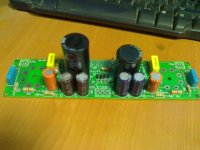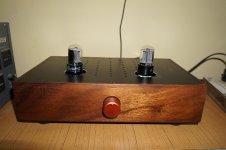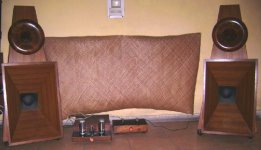Hello,
I would like to build SET amp from this site:
A Low-Cost Single-Ended Triode Amplifier
I have a question about input capacitor. The author used 0.1 uF plastic cap. I have calculated the corner frequency ( I am a newbie in electronics, but I think I got this one correct ) to be 16 Hz. I think it is enough, but for the better bass response is it enough? I do not have any problems with using bigger cap it is just I would like to use polycarbonate cap which I already have. The cap is 0.1 uF/50 Volts. I heard before that polycarbonate capacitors sound close to PIO ones. So, for this circuit, can I use 0.1 uF without ill effect or it is better to go with 1.0 uF or larger?
Thanks
I would like to build SET amp from this site:
A Low-Cost Single-Ended Triode Amplifier
I have a question about input capacitor. The author used 0.1 uF plastic cap. I have calculated the corner frequency ( I am a newbie in electronics, but I think I got this one correct ) to be 16 Hz. I think it is enough, but for the better bass response is it enough? I do not have any problems with using bigger cap it is just I would like to use polycarbonate cap which I already have. The cap is 0.1 uF/50 Volts. I heard before that polycarbonate capacitors sound close to PIO ones. So, for this circuit, can I use 0.1 uF without ill effect or it is better to go with 1.0 uF or larger?
Thanks
Hello Zen Mod,
Thanks for the reply. I am not afraid to use caps in signal path. I would feel safer to use it for protection. I want to use these amps with single-drive speakers. So bass response is sort off important. But, if you think 0.1 uF cap is enough.... I will go with it.
Thanks for the reply. I am not afraid to use caps in signal path. I would feel safer to use it for protection. I want to use these amps with single-drive speakers. So bass response is sort off important. But, if you think 0.1 uF cap is enough.... I will go with it.
The best resistor type in PSU
Hello,
I have another question about this amplifier. It is about type of 100 Ohms/1W R1 resistor in PSU. What type of resistor would be the best sonically in this position: carbon composition, carbon film, metal oxide, .....or metal fim, wire resistor?
This is URL to the amp schematic:
The MiniBlok SET Amp: How It Works
Thx
Hello,
I have another question about this amplifier. It is about type of 100 Ohms/1W R1 resistor in PSU. What type of resistor would be the best sonically in this position: carbon composition, carbon film, metal oxide, .....or metal fim, wire resistor?
This is URL to the amp schematic:
The MiniBlok SET Amp: How It Works
Thx
Last edited:
There is a video clip on you tube about this amp
13EM7 SET amplifier part 1 - YouTube
I made one too on a PCB. Here is a picture of PCB. I will post picture of amp too.
13EM7 SET amplifier part 1 - YouTube
I made one too on a PCB. Here is a picture of PCB. I will post picture of amp too.
Attachments
Carbon comp resistors in the signal path will create noise and distortion, and are expensive and hard to find for a reason, they are obsolete technology. I would recommend using something more modern, metal film being the best all around choice, with corbon film or metal oxide a distant 2nd choice for small wattage resistors in the signal path. As far as using some kind of exotic boutique (expensive garbage) caps, stick with the quality offerings from reputable suppliers and you won't regret it. As far as I can tell the primary function of expensive/boutique parts is extracting as much money as possible from uninformed individuals.
My 2$ worth.
Mike
My 2$ worth.
Mike
IMHO carbon composition resistors still have a use as grid stoppers (blockers). Farnell still stock some carbon composition resistors.
ps I have a lot of low value (<5k) NOS carbon comp. resistors. It would be a shame to throw them away just because it is thought they are so much worse than other resistor types.
ps I have a lot of low value (<5k) NOS carbon comp. resistors. It would be a shame to throw them away just because it is thought they are so much worse than other resistor types.
Last edited:
But they are so much worse than other resistor types. Carbon comp should only be used in three places:Soonerorlater said:ps I have a lot of low value (<5k) NOS carbon comp. resistors. It would be a shame to throw them away just because it is thought they are so much worse than other resistor types.
1. when repairing an old item and wanting to maintain 'authenticity'.
2. when requiring some resistor distortion, as in some guitar amps.
3. when serious transient overload is likely (which is why they are still made) - probably never in most audio circuits.
There is no need to use carbon comp for grid stoppers - this is just an audio myth.
Hello,
Thanks all for replies. I did not get direct answer for my question, but I understand CC resistors are out. Really, I want to use: all carbon film resistors, polycarbonate input cap, and carbon PEC potentiometer. For power transformers....... oh no, I would not have any courage to take X-former apart. It was mentioned in text to use slightly more powerful transformers for higher output. I have already collected four PL30-12-130B power transformers by Tamura: PL30-12-130B Tamura | MT3111-ND | DigiKey
Output transformers are Hammond's 125CSE. I still lack of capacitors and time to finally finish the amp. Since you are willing to help..... does it make any sense to use all carbon film resistors in this amp? I am not "systemphile", but "musicphile". I do like the warmer sound of vacuum tube radios, the ones which I grew up with. I do not want to open another ridiculous topic for people to fight above my head. I did try to look into many threads on the topic and I......gave up. So, will the use of the same type of resistors account for overall sound or there are some places when certain type of resistor will be beneficial for the sound which I look for. I do understand this amp is not HiFi, but this project will be my first attempt at vacuum tube design. I also expect I will live with this amp for a long time before I will try again to build another tube amp. I do not mind to use any suggested type of resistor, but besides above additional questions my main one was not answered. For R1 metal film or metal oxide? I would like to place an order for the missing components and resistors are on the order list.
Thanks again for the help !!!!!
Thanks all for replies. I did not get direct answer for my question, but I understand CC resistors are out. Really, I want to use: all carbon film resistors, polycarbonate input cap, and carbon PEC potentiometer. For power transformers....... oh no, I would not have any courage to take X-former apart. It was mentioned in text to use slightly more powerful transformers for higher output. I have already collected four PL30-12-130B power transformers by Tamura: PL30-12-130B Tamura | MT3111-ND | DigiKey
Output transformers are Hammond's 125CSE. I still lack of capacitors and time to finally finish the amp. Since you are willing to help..... does it make any sense to use all carbon film resistors in this amp? I am not "systemphile", but "musicphile". I do like the warmer sound of vacuum tube radios, the ones which I grew up with. I do not want to open another ridiculous topic for people to fight above my head. I did try to look into many threads on the topic and I......gave up. So, will the use of the same type of resistors account for overall sound or there are some places when certain type of resistor will be beneficial for the sound which I look for. I do understand this amp is not HiFi, but this project will be my first attempt at vacuum tube design. I also expect I will live with this amp for a long time before I will try again to build another tube amp. I do not mind to use any suggested type of resistor, but besides above additional questions my main one was not answered. For R1 metal film or metal oxide? I would like to place an order for the missing components and resistors are on the order list.
Thanks again for the help !!!!!
Last edited:
Hi TB, to directly answer your question re: 150ohm resistor in the power supply, the best option IMO would be a wirewound (the kind that come in the cement blocks). They're cheap, and wirewound resistors only contribute thermal noise (kTBR) with none of the other noise mechanisms associated with other types of resistors.
For the rest of the resistors, metal film will give you the best results in terms of noise - especially in the first stage where most of your gain resides. Resistors in the output power amp (PA) stage have minimal noise contribution because the audio signal + noise applied to the PA will generally mask any noise contribution from resistors in the PA stage.
As far as carbon composition resistors as grid stoppers, that is a holdover from the days when tubes were used as RF amplifiers. The grid-stopper resistor is in series with the signal, and at high frequency (>1MHz or so) any impedance other than the resistance affects circuit performance.
Carbon comp (CC) resistors have extremely low self-inductance, which is a big deal at RF but not so much a consideration at audio frequencies.
In fact, using film resistors for the grid stopper might improve performance as the added inductance will a) improve the lowpass filtering performance (at RF) of the grid stopper working into the tube Miller capacitance and b) better isolate the grid from the rest of the circuit (again at RF) to prevent oscillation of the tube.
Especially in the case of (a), film resistors will help keep RF out of the tube and prevent introduction of the stray electromagnetic interference (EMI) into your amplifier, thus improving performance!
As for the rest of the resistors, I suggest that if you have the values on-hand and want to use them then don't be afraid of doing so.
Stereo amplifiers were built for decades using CC resistors, and granted the performance of those amplifiers isn't up to the finest amplifiers built today using modern parts you will probably be pleasantly surprised at how good an amp can sound even with CC resistors.
If you have the latest 103dB speakers and ultra-gold oxygen-free speaker wires than yeah, you might hear a difference - but if you're just driving an old pair of 83dB Zeniths using zip-cord or something probably not. (BTW - I'm of the old Zenith/zip-cord school FWIW )
)
If you are purchasing resistors, then the metal film types are the way to go. They're dirt cheap (1/2 watt, 1% leaded resistors run 10-cents each at Mouser, I just ordered a bunch for another project ) and available in pretty much any value you need. They also come in 1W and 2W flavors, with perhaps less choice in values but still a good value.
) and available in pretty much any value you need. They also come in 1W and 2W flavors, with perhaps less choice in values but still a good value.
When you get into building that tube phono-preamp is the time to really worry about resistor noise - for this amp, especially if you're running an iPod into it - go with what you have and have a blast!
~ Sam
EDIT - Besides, once you get the amp built and working you can play with different resistor types to see what difference, if any, it makes to your ears. For a good guide on parts selection, check out TubeLab's parts lists. He has provided suggested parts for his designs, along with manufacturer part numbers, that are commonly available from Digi or Mouser and won't break the bank!
Stick with parts in those families (even if the value TubeLab uses is different from yours) and you can't go wrong IMHO.
For the rest of the resistors, metal film will give you the best results in terms of noise - especially in the first stage where most of your gain resides. Resistors in the output power amp (PA) stage have minimal noise contribution because the audio signal + noise applied to the PA will generally mask any noise contribution from resistors in the PA stage.
As far as carbon composition resistors as grid stoppers, that is a holdover from the days when tubes were used as RF amplifiers. The grid-stopper resistor is in series with the signal, and at high frequency (>1MHz or so) any impedance other than the resistance affects circuit performance.
Carbon comp (CC) resistors have extremely low self-inductance, which is a big deal at RF but not so much a consideration at audio frequencies.
In fact, using film resistors for the grid stopper might improve performance as the added inductance will a) improve the lowpass filtering performance (at RF) of the grid stopper working into the tube Miller capacitance and b) better isolate the grid from the rest of the circuit (again at RF) to prevent oscillation of the tube.
Especially in the case of (a), film resistors will help keep RF out of the tube and prevent introduction of the stray electromagnetic interference (EMI) into your amplifier, thus improving performance!
As for the rest of the resistors, I suggest that if you have the values on-hand and want to use them then don't be afraid of doing so.
Stereo amplifiers were built for decades using CC resistors, and granted the performance of those amplifiers isn't up to the finest amplifiers built today using modern parts you will probably be pleasantly surprised at how good an amp can sound even with CC resistors.
If you have the latest 103dB speakers and ultra-gold oxygen-free speaker wires than yeah, you might hear a difference - but if you're just driving an old pair of 83dB Zeniths using zip-cord or something probably not. (BTW - I'm of the old Zenith/zip-cord school FWIW
If you are purchasing resistors, then the metal film types are the way to go. They're dirt cheap (1/2 watt, 1% leaded resistors run 10-cents each at Mouser, I just ordered a bunch for another project
When you get into building that tube phono-preamp is the time to really worry about resistor noise - for this amp, especially if you're running an iPod into it - go with what you have and have a blast!
~ Sam
EDIT - Besides, once you get the amp built and working you can play with different resistor types to see what difference, if any, it makes to your ears. For a good guide on parts selection, check out TubeLab's parts lists. He has provided suggested parts for his designs, along with manufacturer part numbers, that are commonly available from Digi or Mouser and won't break the bank!
Stick with parts in those families (even if the value TubeLab uses is different from yours) and you can't go wrong IMHO.
Last edited:
Should sound great!
I've been running a new TubeLab SE for the past month or so, and it does make the old music sound _so much better than I had heard in years.
Even songs that I knew by heart sound fresh and new - I think you will be pleasantly surprised with your result.
Best luck to you!
I've been running a new TubeLab SE for the past month or so, and it does make the old music sound _so much better than I had heard in years.
Even songs that I knew by heart sound fresh and new - I think you will be pleasantly surprised with your result.
Best luck to you!
Hello JPS,
Very nice amp. I like it very much. Now, in your answer you refer to the "output cap". Which cap do you mean? I see output transformer, but no output cap.
The MiniBlok SET Amp: How It Works
Sorry for incorrect wording. I used Russian PIO for C7 and Black Gate for C8. I used custom wound power transformer instead of two transformers as used by FN . I also used a choke instead of R1.
Here is another picture of smaller MiniBlok SET amp driving large size speakers which are normally used with GM70 SE amp which is also shown in picture.
Attachments
I made one of these with an Ipod dock, taking the sound out thru the 30 pin plug for my 12 year old daughter, with some Zigmahornets. I have tried to pry it from her warm compressed pop listening ears ever since. Its a great sounding amp. Loud enough for a small bedroom. I built it as per schematic but put a bigger PT because it was convenient
there are pics on this forum somewhere
there are pics on this forum somewhere
- Status
- This old topic is closed. If you want to reopen this topic, contact a moderator using the "Report Post" button.
- Home
- Amplifiers
- Tubes / Valves
- Fred Nachbaur SET amp: input capacitor



